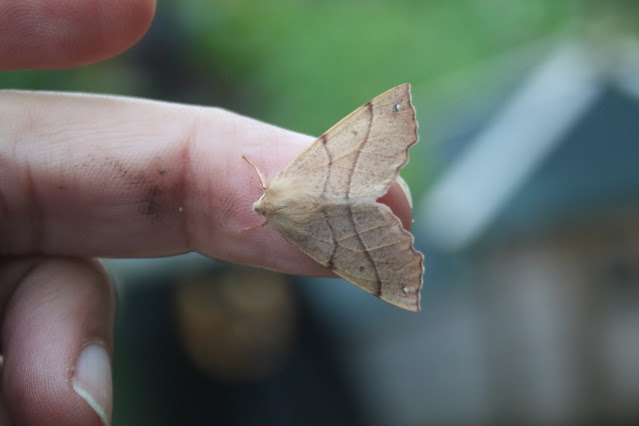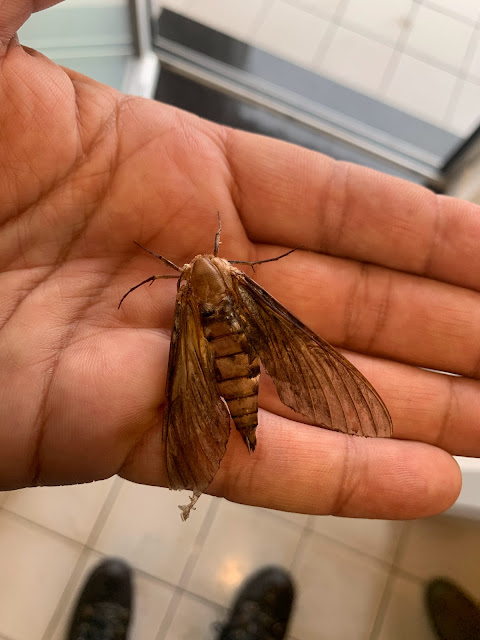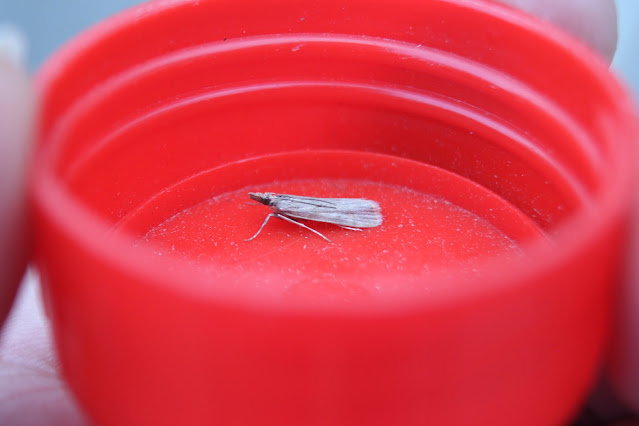Latest update on this: the project moth list is now on 316 species I-Naturalist Project Here and thanks to Steve and the Bulgaria I-Naturalist Moth Group the highlights identified include the species below. These records have been selected for inclusion in a Data Paper for the Bulgarian Academy of Sciences so very pleased that the project is yielding regionally important moth records as we hoped.
Sunday, 26 November 2023
Bulgaria Project Moths Update
Saturday, 25 November 2023
Winter moths?
Friday, 24 November 2023
Burying your head in the sandpipers
Tuesday, 21 November 2023
American Moorhen versus European Moorhen, First-winters
Spent the day at Tring today having a look at the Moorhen skins. Here's a few notes on separating American Moorhen and European Moorhen in first-winter plumages in a vagrant context. There is no currently acceptable way of separating these in the field in first-winter so hopefully there are a few ideas/observations here that may be useful and in the right direction. David Sibley has written a couple of articles on separating adults and there is an account in Martin Garner's original Birding Frontiers on the identification of Laughing Moorhen which form the foundation of some of the notes here. Towards the end of this post we have a look at the two Moorhens that we recorded on the Azores this October to see if we can make a call before the DNA results come in.
IDENTIFICATION SUMMARY
First-winter American Moorhen features: Warm brown upperparts (mantle and scapulars) contrastingly strongly with a plumbeous (lead grey) head and neck. The underparts are also grey (and white) lacking the brown tones (mainly in the breast) of European Moorhen. American Moorhen tend to show limited white on the head and throat as opposed to European Moorhen which sometimes has a buff/pale throat set against a brown breast and neck. The bill is longer in American and the frontal shield is more extensive, reaching the top of the eye and is often squared off. The bill colouration on American tends to show less yellow and restricted to a triangle on the bill tip. The tarsus is longer on American Moorhen and overall the bird appears more gallinule like.
First-winter European Moorhen features: Olive-brown upperparts (mantle and scapulars) contrastingly weakly with a brown neck and head. The underparts tend to have brown particularly in the upper breast and overall lack the strongly contrasting and grey underparts and head and neck of American. The bill and frontal shield are smaller, the frontal shield often reaches below the eye and is often rounded unlike the squared off shield of American. Yellow in the bill is often more extensive. The tarsus is shorter and overall the bird is more crake like as opposed to the more gallinule like structure of American Moorhen.
UPPERPART CONTRAST
Sunday, 19 November 2023
Old Vic end of autumn moths
The night temperatures have been around 8 to 10 degrees over the last couple of nights so I lit up again, the first time in a while. Had an Olive-tree Pearl, Palpita vitrealis today which is a NFY and always a welcome migrant visitor here and very good to get a migrant this late in the year. The full list of other moths recorded include Sprawler, December moth, Feathered Thorn, Brick, Red-line Quaker, Common Flat-body, Agonopterix hericliana and Light Brown Apple Moth. Moth garden year list is now 469 (633 all time).
In other news our offer on the Selsey property has been accepted and we are moving towards the memorandum of sale and getting the surveys done. Here at the Old Vic, exchange contracts have been signed and the completion date is in early December so things are suddenly moving very fast on this. There will be a few months in rental between moving out of here and moving into the new house so still a long way to go. On reflection it was great to get another year here at the Old Vic- I suspect I won't find a better moth trapping garden again, considering I'm not here half the time, getting nearly 500 species a year must indicate a special place. I feel like I certainly made the most out of it, even at the expense of birding time but these inner landlocked counties seem to be better for ecology overall rather than 'birding' so it seemed to make sense to focus on that as a better 'investment'. The learning curve has been steep and very enjoyable and I'm indebted to all the help from Dave Wilton and the Upper Thames Moths Community who incidentally have an upgraded website (now includes micro records) HERE. I've absolutely loved our time here.
However, I'm not gonna lie, if all goes to plan and we end up on the coast, I will finally, after decades of being landlocked, at last live next to a decent local patch to go birding on, which I'm very much looking forward to. When at the Old Vic, doing the mini-farming and wildlife garden and local exploring etc I often thought, just imagine this.... on the coast! So that's the plan to recreate here, there. The Selsey property will be walking distance from Pagham harbour and a couple of miles from Medmerry and Selsey Bill for sea watching and also to the north we will have access to the South Downs to do more ecology stuff too. The local schools are good, the commute to London is about the same as from here and the whole family already know and love the area as it's our regular holiday spot. I'm also hoping will get more moth migrant activity down there too especially if we create some decent habitat in the garden. Fingers crossed it comes off!
Thursday, 16 November 2023
Corvo 2023- a record-breaking season
Here's a Birdguides article on the epic season on Corvo this year: CORVO 2023
Sunday, 12 November 2023
The Old Vic update
Last update I did from the Old Vic was on 21st October, since then I've either been on Corvo or since getting back catching up with work and doing the post trip write ups etc. I did my first Ebird list this morning in a while HERE which is one of my best days garden birding with nearly 1000 individuals of 34 species including a garden tick- a Merlin that presumably has strayed from the nearby airfield where I've seen them several times before. Woodpigeons and Stock Doves were on the move as were Redwings and Fieldfares and there was also a flock of Siskin and a couple of Redpoll.
Other news from here is that in preparation to move we have re-homed the chickens with Isaac's child minder and if all goes to plan we should be moving out of here in early December and moving into a temporary rental property in Brill, a hilltop location where I've done some vis-migging from in the past. Longer term we have found a homestead on the Selsey Peninsula which if all goes well we should be ready to move into during the Spring. Fingers crossed! If it actually comes off it will be brilliant but this whole thing has been a rollercoaster ride with lots of ups and downs and twists and turns so will hope for the best and hang on.
I've had the moth trap out a couple of times but literally nothing during these cold and wet nights that I've come back to.
The logistics of moving our '100 species of pets' is dawning on me (or rather haunting me). We've lost control of the reef tank after taking our eye off the ball while travelling and had a tank crash (lost our three reef fish, the starfish and some corals) and now out of control algae which we can't get control of yet. A bit of a lesson in biochemistry and one we hope to crack this week.
In the mini-farm I've been dismantling the chicken infrastructure and we harvested some brussel sprouts and cabbages this week too. All rather sad winding all this down but excited about starting again with all the lessons we've learnt in what we are optimistically and hopefully calling our 'forever' home in the Spring.
Friday, 10 November 2023
Off to the Lab
Monday, 6 November 2023
Saturday, 4 November 2023
Azores Moths 2023
Despite trapping nearly every night while on Corvo there wasn't much to show for it. I could only transport the LED trap which generally works better in areas of high moth density. I've been bringing a trap to Corvo for several years now but still no sign of any American migrants. I suspect we would need MVs and generators as it appears that it will be quite a challenge. Despite there being multiple American Painted Ladies and Green Darners in the UK this autumn, nothing in the way of Nearctic entomology has been reported from the Azores despite the record breaking american bird migrant autumn. I didn't even catch one of the American species that have colonised the Azores- White Speck (American Wainscot) or Wedgling which were numerous in previous years that I tried the trap out.
I did see a Painted Lady sp when David and I were looking for the Wood Thrush but didn't see it well enough to conclude whether an American or European.
Anyway, here's a few of the moths that either turned up in the trap or were flying during the day.
Azores moths on Lepiforum HERE.
Lepidoptera list on Azores Wildlife website HERE
Previous moth trapping on Azores HERE

%20Dichagyris%20candelisequa.jpeg)
%20Dichagyris%20melanura.jpeg)
%20Cervyna%20cervago.jpeg)
%20Epilecta%20linogrisea.jpeg)
%20Dioszeghyana%20schmidtill.jpeg)
.jpeg)
%20a%20nitida.jpeg)
%20Athethmia%20ambusta.jpeg)
.jpeg)
%20Eublemma%20sauva.jpeg)
%20Euclidia%20triquetra.jpeg)
%20Garella%20musculana.jpeg)
%20Hoplodrina%20octogenaria.jpeg)
%20Luperina%20rubella.jpeg)
%20Noctua%20janthina.jpeg)
%20Xestia%20cohaesa.jpeg)






.jpg)

.jpg)
.jpg)
.jpg)
.jpg)
.jpg)
.jpg)



.jpg)
.jpg)
.jpg)
























